An Exploration of Anti-D Prophylaxis Alternatives in Antenatal Care
VerifiedAdded on 2023/04/04
|28
|7524
|143
Thesis and Dissertation
AI Summary
This dissertation explores alternative options for routine administration of antenatal Anti-D prophylaxis, focusing on the context of rhesus D (RhD) negative women and the potential for alloimmunization. The study employs a rapid evidence assessment methodology to evaluate the current practice of routine anti-D immunoglobulin prophylaxis (RAADP) and investigate potential alternatives, such as high-throughput non-invasive prenatal testing (HT-NIPT) for fetal RhD status. The research aims to determine the reliability, sensitivity, and generalizability of these alternatives within the UK population, considering cost-effectiveness and ethical implications. The dissertation reviews existing literature, including studies on non-invasive prenatal diagnosis (NIPD), and assesses the potential benefits of targeted anti-D immunoglobulin policies. It also analyzes the rationale behind topic selection, the research methodology used, and the limitations of the study, concluding with a discussion on the potential for improved healthcare practices in antenatal care for RhD negative women.
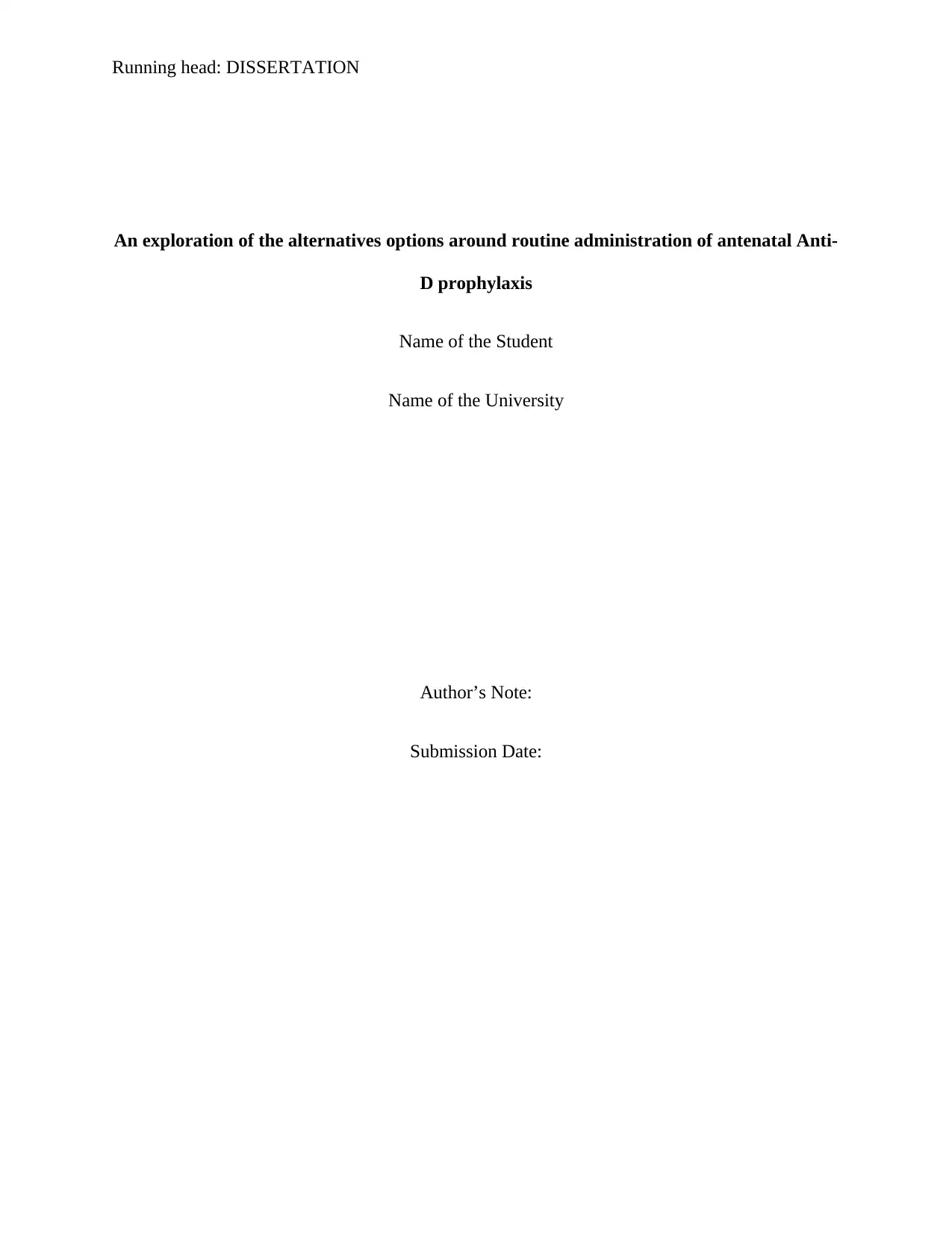
Running head: DISSERTATION
An exploration of the alternatives options around routine administration of antenatal Anti-
D prophylaxis
Name of the Student
Name of the University
Author’s Note:
Submission Date:
An exploration of the alternatives options around routine administration of antenatal Anti-
D prophylaxis
Name of the Student
Name of the University
Author’s Note:
Submission Date:
Paraphrase This Document
Need a fresh take? Get an instant paraphrase of this document with our AI Paraphraser

1DISSERTATION
Acknowledgement
I want to offer the deepest appreciation to Professor ________________, who has the attitude
and essence of a genius: a spirit of Adventure in research and scholarship and an excitement in
the fields of teaching have been constantly and persuasively conveyed. This thesis would not
have been feasible without his/ her guidance and constant support.
I wish to thank my employees, Professor __________ and Professor _________, whose job has
shown me that worldwide affairs backed by comparative literature and contemporary technology
are always supposed to transcend universities and make our search for our times.
I want to give thanks to my loved ones, my family and friends who helped me greatly finalize the
project within a restricted time frame and who supported me throughout the entire process. For
your love, I will always be thankful.
Sincerely,
Student’s Name
Acknowledgement
I want to offer the deepest appreciation to Professor ________________, who has the attitude
and essence of a genius: a spirit of Adventure in research and scholarship and an excitement in
the fields of teaching have been constantly and persuasively conveyed. This thesis would not
have been feasible without his/ her guidance and constant support.
I wish to thank my employees, Professor __________ and Professor _________, whose job has
shown me that worldwide affairs backed by comparative literature and contemporary technology
are always supposed to transcend universities and make our search for our times.
I want to give thanks to my loved ones, my family and friends who helped me greatly finalize the
project within a restricted time frame and who supported me throughout the entire process. For
your love, I will always be thankful.
Sincerely,
Student’s Name
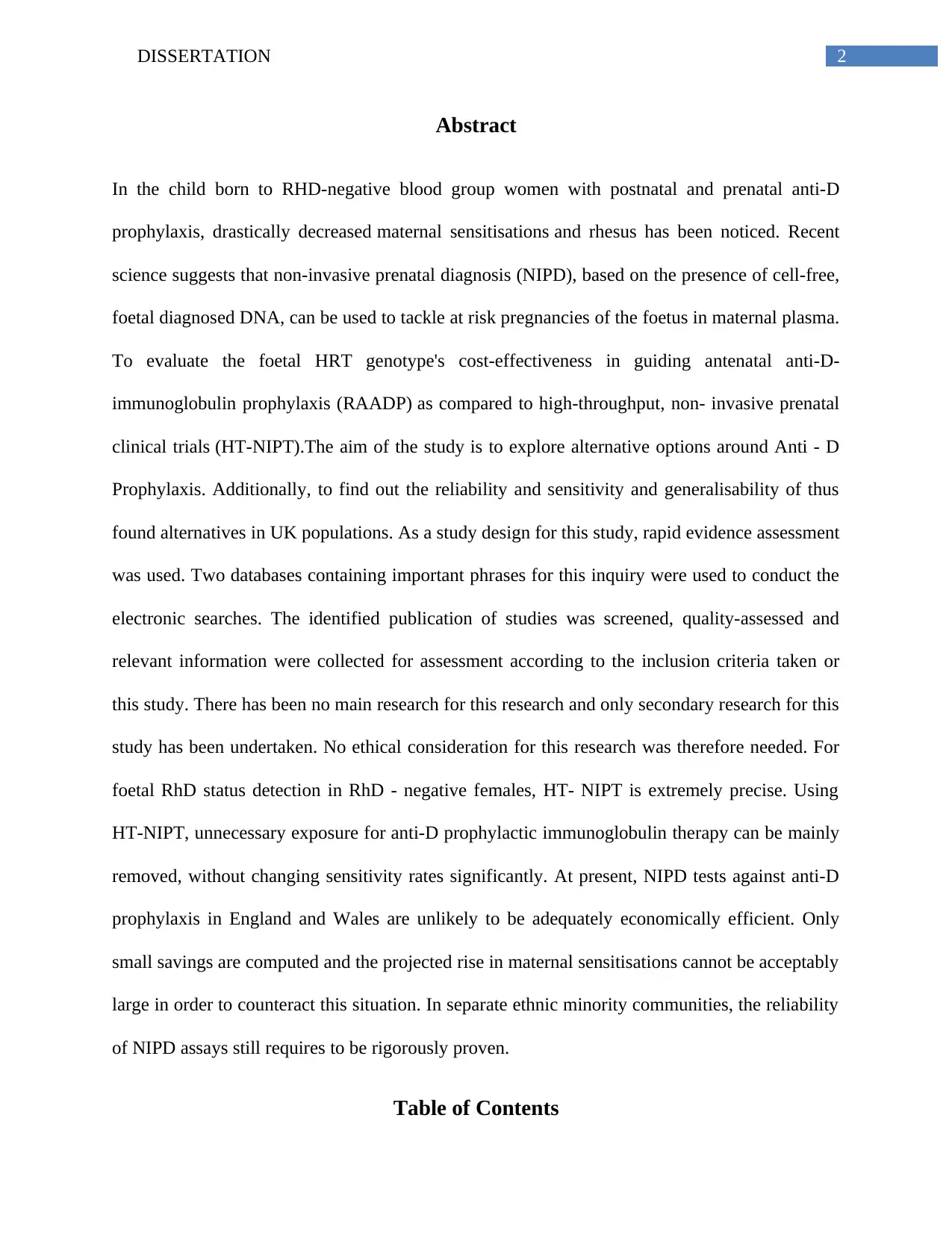
2DISSERTATION
Abstract
In the child born to RHD-negative blood group women with postnatal and prenatal anti-D
prophylaxis, drastically decreased maternal sensitisations and rhesus has been noticed. Recent
science suggests that non-invasive prenatal diagnosis (NIPD), based on the presence of cell-free,
foetal diagnosed DNA, can be used to tackle at risk pregnancies of the foetus in maternal plasma.
To evaluate the foetal HRT genotype's cost-effectiveness in guiding antenatal anti-D-
immunoglobulin prophylaxis (RAADP) as compared to high-throughput, non- invasive prenatal
clinical trials (HT-NIPT).The aim of the study is to explore alternative options around Anti - D
Prophylaxis. Additionally, to find out the reliability and sensitivity and generalisability of thus
found alternatives in UK populations. As a study design for this study, rapid evidence assessment
was used. Two databases containing important phrases for this inquiry were used to conduct the
electronic searches. The identified publication of studies was screened, quality-assessed and
relevant information were collected for assessment according to the inclusion criteria taken or
this study. There has been no main research for this research and only secondary research for this
study has been undertaken. No ethical consideration for this research was therefore needed. For
foetal RhD status detection in RhD - negative females, HT- NIPT is extremely precise. Using
HT-NIPT, unnecessary exposure for anti-D prophylactic immunoglobulin therapy can be mainly
removed, without changing sensitivity rates significantly. At present, NIPD tests against anti-D
prophylaxis in England and Wales are unlikely to be adequately economically efficient. Only
small savings are computed and the projected rise in maternal sensitisations cannot be acceptably
large in order to counteract this situation. In separate ethnic minority communities, the reliability
of NIPD assays still requires to be rigorously proven.
Table of Contents
Abstract
In the child born to RHD-negative blood group women with postnatal and prenatal anti-D
prophylaxis, drastically decreased maternal sensitisations and rhesus has been noticed. Recent
science suggests that non-invasive prenatal diagnosis (NIPD), based on the presence of cell-free,
foetal diagnosed DNA, can be used to tackle at risk pregnancies of the foetus in maternal plasma.
To evaluate the foetal HRT genotype's cost-effectiveness in guiding antenatal anti-D-
immunoglobulin prophylaxis (RAADP) as compared to high-throughput, non- invasive prenatal
clinical trials (HT-NIPT).The aim of the study is to explore alternative options around Anti - D
Prophylaxis. Additionally, to find out the reliability and sensitivity and generalisability of thus
found alternatives in UK populations. As a study design for this study, rapid evidence assessment
was used. Two databases containing important phrases for this inquiry were used to conduct the
electronic searches. The identified publication of studies was screened, quality-assessed and
relevant information were collected for assessment according to the inclusion criteria taken or
this study. There has been no main research for this research and only secondary research for this
study has been undertaken. No ethical consideration for this research was therefore needed. For
foetal RhD status detection in RhD - negative females, HT- NIPT is extremely precise. Using
HT-NIPT, unnecessary exposure for anti-D prophylactic immunoglobulin therapy can be mainly
removed, without changing sensitivity rates significantly. At present, NIPD tests against anti-D
prophylaxis in England and Wales are unlikely to be adequately economically efficient. Only
small savings are computed and the projected rise in maternal sensitisations cannot be acceptably
large in order to counteract this situation. In separate ethnic minority communities, the reliability
of NIPD assays still requires to be rigorously proven.
Table of Contents
⊘ This is a preview!⊘
Do you want full access?
Subscribe today to unlock all pages.

Trusted by 1+ million students worldwide
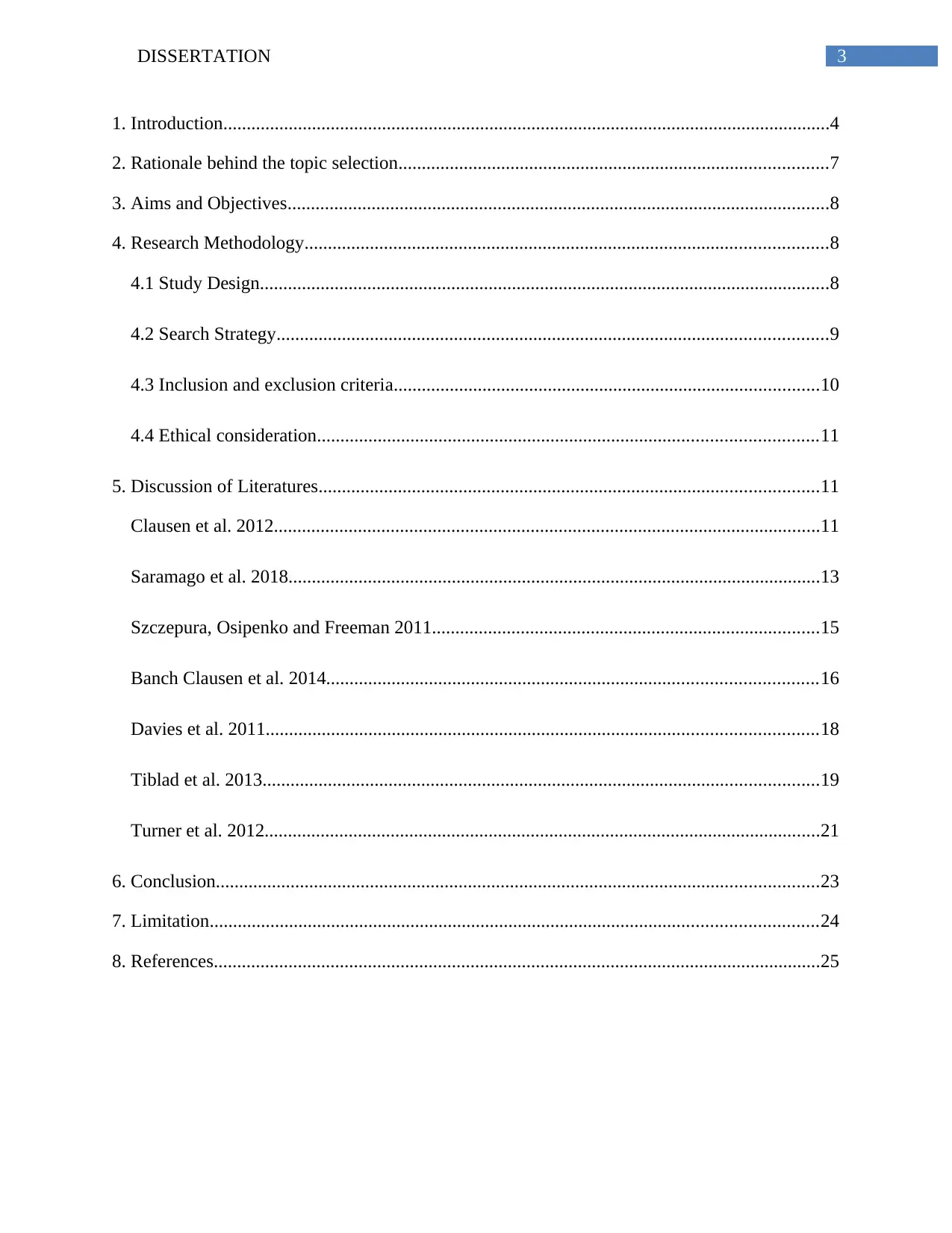
3DISSERTATION
1. Introduction..................................................................................................................................4
2. Rationale behind the topic selection............................................................................................7
3. Aims and Objectives....................................................................................................................8
4. Research Methodology................................................................................................................8
4.1 Study Design..........................................................................................................................8
4.2 Search Strategy......................................................................................................................9
4.3 Inclusion and exclusion criteria...........................................................................................10
4.4 Ethical consideration...........................................................................................................11
5. Discussion of Literatures...........................................................................................................11
Clausen et al. 2012.....................................................................................................................11
Saramago et al. 2018..................................................................................................................13
Szczepura, Osipenko and Freeman 2011...................................................................................15
Banch Clausen et al. 2014.........................................................................................................16
Davies et al. 2011......................................................................................................................18
Tiblad et al. 2013.......................................................................................................................19
Turner et al. 2012.......................................................................................................................21
6. Conclusion.................................................................................................................................23
7. Limitation..................................................................................................................................24
8. References..................................................................................................................................25
1. Introduction..................................................................................................................................4
2. Rationale behind the topic selection............................................................................................7
3. Aims and Objectives....................................................................................................................8
4. Research Methodology................................................................................................................8
4.1 Study Design..........................................................................................................................8
4.2 Search Strategy......................................................................................................................9
4.3 Inclusion and exclusion criteria...........................................................................................10
4.4 Ethical consideration...........................................................................................................11
5. Discussion of Literatures...........................................................................................................11
Clausen et al. 2012.....................................................................................................................11
Saramago et al. 2018..................................................................................................................13
Szczepura, Osipenko and Freeman 2011...................................................................................15
Banch Clausen et al. 2014.........................................................................................................16
Davies et al. 2011......................................................................................................................18
Tiblad et al. 2013.......................................................................................................................19
Turner et al. 2012.......................................................................................................................21
6. Conclusion.................................................................................................................................23
7. Limitation..................................................................................................................................24
8. References..................................................................................................................................25
Paraphrase This Document
Need a fresh take? Get an instant paraphrase of this document with our AI Paraphraser
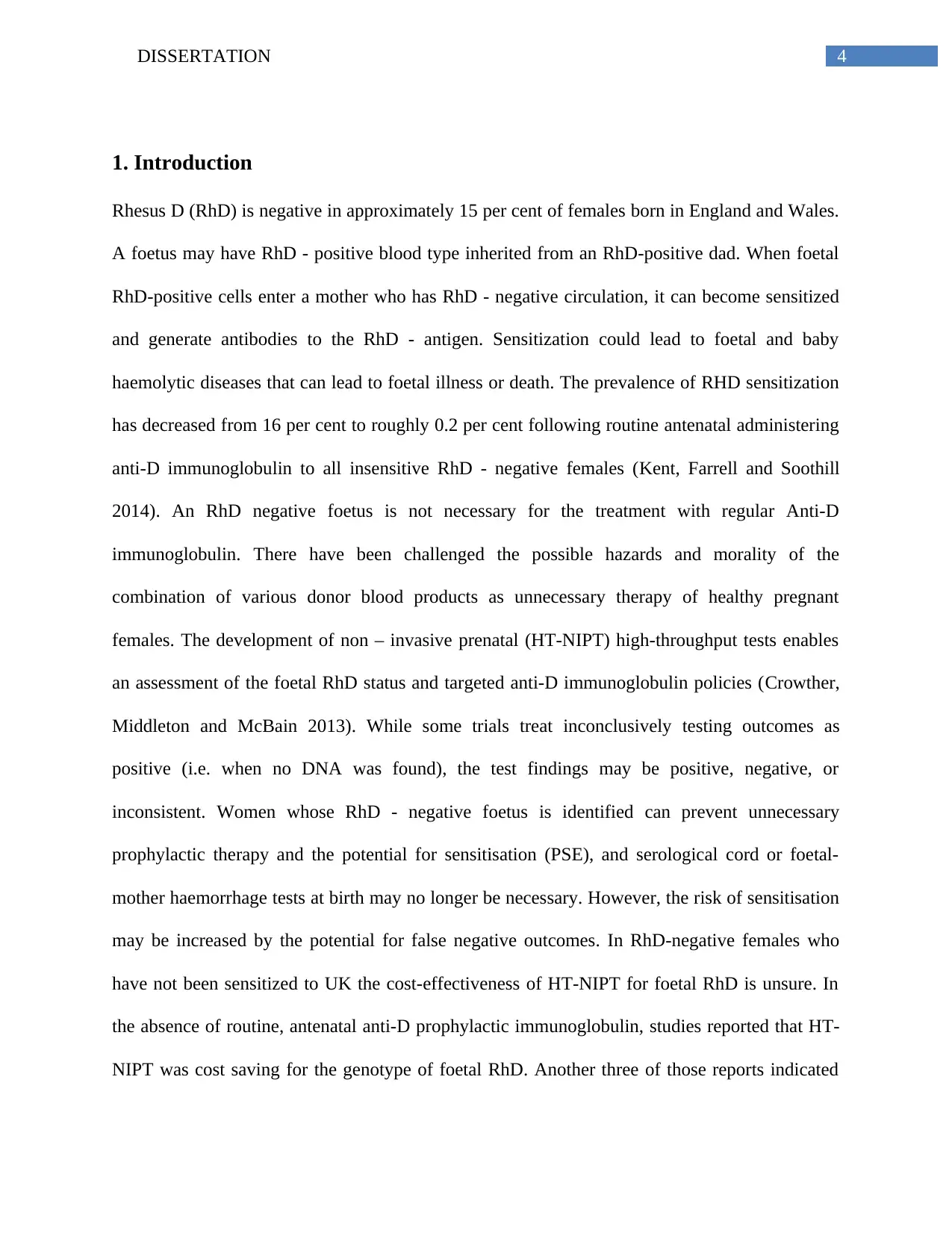
4DISSERTATION
1. Introduction
Rhesus D (RhD) is negative in approximately 15 per cent of females born in England and Wales.
A foetus may have RhD - positive blood type inherited from an RhD-positive dad. When foetal
RhD-positive cells enter a mother who has RhD - negative circulation, it can become sensitized
and generate antibodies to the RhD - antigen. Sensitization could lead to foetal and baby
haemolytic diseases that can lead to foetal illness or death. The prevalence of RHD sensitization
has decreased from 16 per cent to roughly 0.2 per cent following routine antenatal administering
anti-D immunoglobulin to all insensitive RhD - negative females (Kent, Farrell and Soothill
2014). An RhD negative foetus is not necessary for the treatment with regular Anti-D
immunoglobulin. There have been challenged the possible hazards and morality of the
combination of various donor blood products as unnecessary therapy of healthy pregnant
females. The development of non – invasive prenatal (HT-NIPT) high-throughput tests enables
an assessment of the foetal RhD status and targeted anti-D immunoglobulin policies (Crowther,
Middleton and McBain 2013). While some trials treat inconclusively testing outcomes as
positive (i.e. when no DNA was found), the test findings may be positive, negative, or
inconsistent. Women whose RhD - negative foetus is identified can prevent unnecessary
prophylactic therapy and the potential for sensitisation (PSE), and serological cord or foetal-
mother haemorrhage tests at birth may no longer be necessary. However, the risk of sensitisation
may be increased by the potential for false negative outcomes. In RhD-negative females who
have not been sensitized to UK the cost-effectiveness of HT-NIPT for foetal RhD is unsure. In
the absence of routine, antenatal anti-D prophylactic immunoglobulin, studies reported that HT-
NIPT was cost saving for the genotype of foetal RhD. Another three of those reports indicated
1. Introduction
Rhesus D (RhD) is negative in approximately 15 per cent of females born in England and Wales.
A foetus may have RhD - positive blood type inherited from an RhD-positive dad. When foetal
RhD-positive cells enter a mother who has RhD - negative circulation, it can become sensitized
and generate antibodies to the RhD - antigen. Sensitization could lead to foetal and baby
haemolytic diseases that can lead to foetal illness or death. The prevalence of RHD sensitization
has decreased from 16 per cent to roughly 0.2 per cent following routine antenatal administering
anti-D immunoglobulin to all insensitive RhD - negative females (Kent, Farrell and Soothill
2014). An RhD negative foetus is not necessary for the treatment with regular Anti-D
immunoglobulin. There have been challenged the possible hazards and morality of the
combination of various donor blood products as unnecessary therapy of healthy pregnant
females. The development of non – invasive prenatal (HT-NIPT) high-throughput tests enables
an assessment of the foetal RhD status and targeted anti-D immunoglobulin policies (Crowther,
Middleton and McBain 2013). While some trials treat inconclusively testing outcomes as
positive (i.e. when no DNA was found), the test findings may be positive, negative, or
inconsistent. Women whose RhD - negative foetus is identified can prevent unnecessary
prophylactic therapy and the potential for sensitisation (PSE), and serological cord or foetal-
mother haemorrhage tests at birth may no longer be necessary. However, the risk of sensitisation
may be increased by the potential for false negative outcomes. In RhD-negative females who
have not been sensitized to UK the cost-effectiveness of HT-NIPT for foetal RhD is unsure. In
the absence of routine, antenatal anti-D prophylactic immunoglobulin, studies reported that HT-
NIPT was cost saving for the genotype of foetal RhD. Another three of those reports indicated
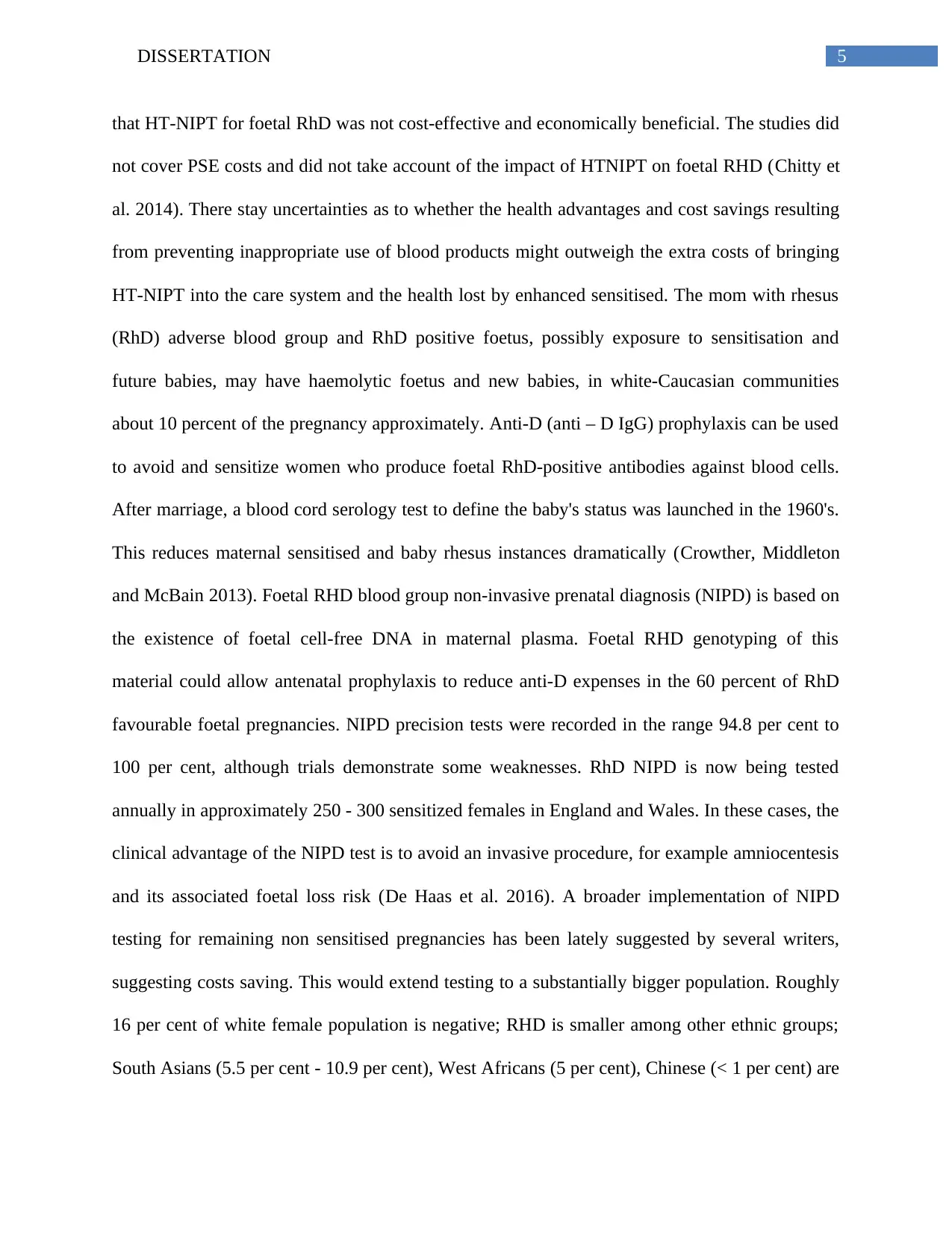
5DISSERTATION
that HT-NIPT for foetal RhD was not cost-effective and economically beneficial. The studies did
not cover PSE costs and did not take account of the impact of HTNIPT on foetal RHD (Chitty et
al. 2014). There stay uncertainties as to whether the health advantages and cost savings resulting
from preventing inappropriate use of blood products might outweigh the extra costs of bringing
HT-NIPT into the care system and the health lost by enhanced sensitised. The mom with rhesus
(RhD) adverse blood group and RhD positive foetus, possibly exposure to sensitisation and
future babies, may have haemolytic foetus and new babies, in white-Caucasian communities
about 10 percent of the pregnancy approximately. Anti-D (anti – D IgG) prophylaxis can be used
to avoid and sensitize women who produce foetal RhD-positive antibodies against blood cells.
After marriage, a blood cord serology test to define the baby's status was launched in the 1960's.
This reduces maternal sensitised and baby rhesus instances dramatically (Crowther, Middleton
and McBain 2013). Foetal RHD blood group non-invasive prenatal diagnosis (NIPD) is based on
the existence of foetal cell-free DNA in maternal plasma. Foetal RHD genotyping of this
material could allow antenatal prophylaxis to reduce anti-D expenses in the 60 percent of RhD
favourable foetal pregnancies. NIPD precision tests were recorded in the range 94.8 per cent to
100 per cent, although trials demonstrate some weaknesses. RhD NIPD is now being tested
annually in approximately 250 - 300 sensitized females in England and Wales. In these cases, the
clinical advantage of the NIPD test is to avoid an invasive procedure, for example amniocentesis
and its associated foetal loss risk (De Haas et al. 2016). A broader implementation of NIPD
testing for remaining non sensitised pregnancies has been lately suggested by several writers,
suggesting costs saving. This would extend testing to a substantially bigger population. Roughly
16 per cent of white female population is negative; RHD is smaller among other ethnic groups;
South Asians (5.5 per cent - 10.9 per cent), West Africans (5 per cent), Chinese (< 1 per cent) are
that HT-NIPT for foetal RhD was not cost-effective and economically beneficial. The studies did
not cover PSE costs and did not take account of the impact of HTNIPT on foetal RHD (Chitty et
al. 2014). There stay uncertainties as to whether the health advantages and cost savings resulting
from preventing inappropriate use of blood products might outweigh the extra costs of bringing
HT-NIPT into the care system and the health lost by enhanced sensitised. The mom with rhesus
(RhD) adverse blood group and RhD positive foetus, possibly exposure to sensitisation and
future babies, may have haemolytic foetus and new babies, in white-Caucasian communities
about 10 percent of the pregnancy approximately. Anti-D (anti – D IgG) prophylaxis can be used
to avoid and sensitize women who produce foetal RhD-positive antibodies against blood cells.
After marriage, a blood cord serology test to define the baby's status was launched in the 1960's.
This reduces maternal sensitised and baby rhesus instances dramatically (Crowther, Middleton
and McBain 2013). Foetal RHD blood group non-invasive prenatal diagnosis (NIPD) is based on
the existence of foetal cell-free DNA in maternal plasma. Foetal RHD genotyping of this
material could allow antenatal prophylaxis to reduce anti-D expenses in the 60 percent of RhD
favourable foetal pregnancies. NIPD precision tests were recorded in the range 94.8 per cent to
100 per cent, although trials demonstrate some weaknesses. RhD NIPD is now being tested
annually in approximately 250 - 300 sensitized females in England and Wales. In these cases, the
clinical advantage of the NIPD test is to avoid an invasive procedure, for example amniocentesis
and its associated foetal loss risk (De Haas et al. 2016). A broader implementation of NIPD
testing for remaining non sensitised pregnancies has been lately suggested by several writers,
suggesting costs saving. This would extend testing to a substantially bigger population. Roughly
16 per cent of white female population is negative; RHD is smaller among other ethnic groups;
South Asians (5.5 per cent - 10.9 per cent), West Africans (5 per cent), Chinese (< 1 per cent) are
⊘ This is a preview!⊘
Do you want full access?
Subscribe today to unlock all pages.

Trusted by 1+ million students worldwide
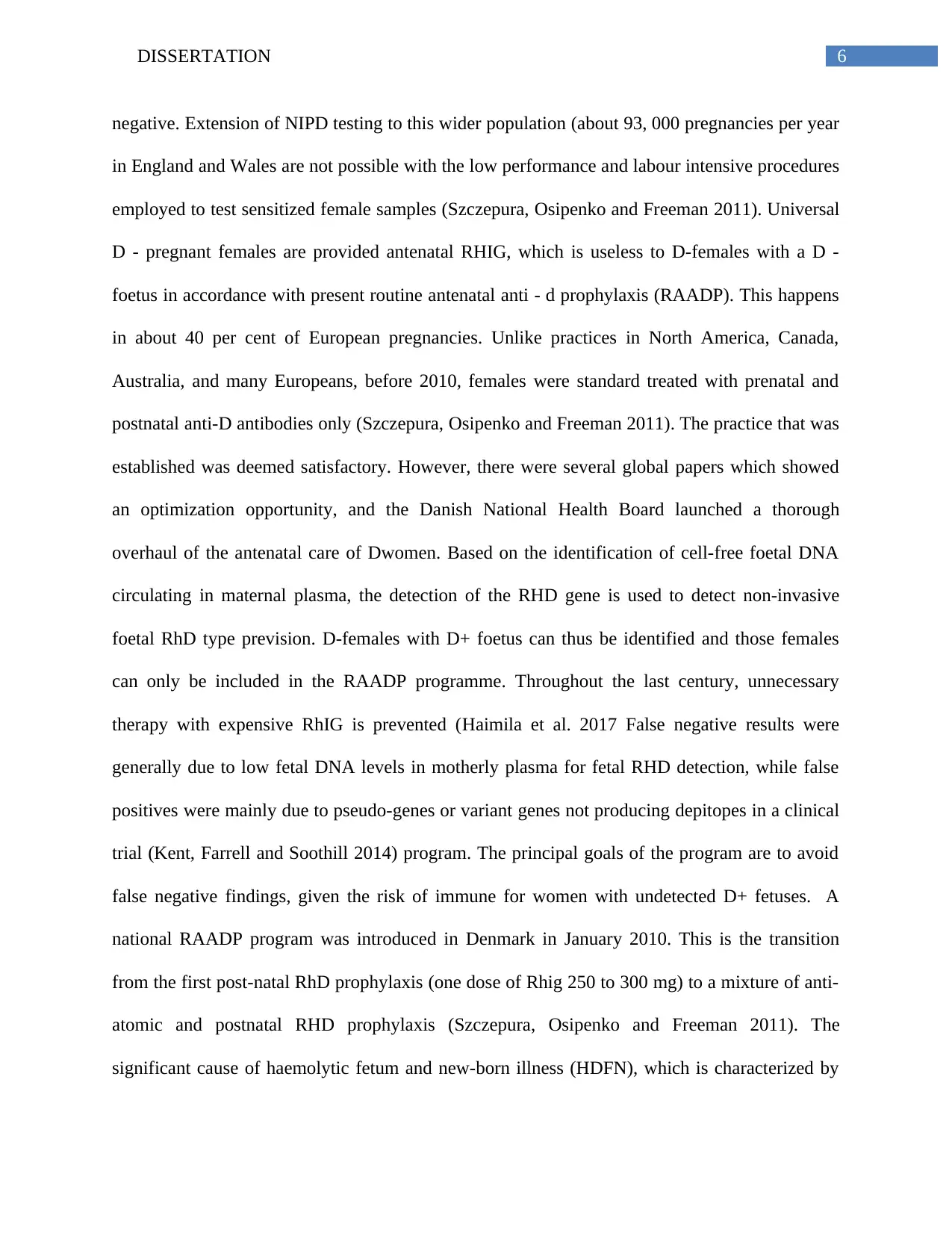
6DISSERTATION
negative. Extension of NIPD testing to this wider population (about 93, 000 pregnancies per year
in England and Wales are not possible with the low performance and labour intensive procedures
employed to test sensitized female samples (Szczepura, Osipenko and Freeman 2011). Universal
D - pregnant females are provided antenatal RHIG, which is useless to D-females with a D -
foetus in accordance with present routine antenatal anti - d prophylaxis (RAADP). This happens
in about 40 per cent of European pregnancies. Unlike practices in North America, Canada,
Australia, and many Europeans, before 2010, females were standard treated with prenatal and
postnatal anti-D antibodies only (Szczepura, Osipenko and Freeman 2011). The practice that was
established was deemed satisfactory. However, there were several global papers which showed
an optimization opportunity, and the Danish National Health Board launched a thorough
overhaul of the antenatal care of Dwomen. Based on the identification of cell-free foetal DNA
circulating in maternal plasma, the detection of the RHD gene is used to detect non-invasive
foetal RhD type prevision. D-females with D+ foetus can thus be identified and those females
can only be included in the RAADP programme. Throughout the last century, unnecessary
therapy with expensive RhIG is prevented (Haimila et al. 2017 False negative results were
generally due to low fetal DNA levels in motherly plasma for fetal RHD detection, while false
positives were mainly due to pseudo-genes or variant genes not producing depitopes in a clinical
trial (Kent, Farrell and Soothill 2014) program. The principal goals of the program are to avoid
false negative findings, given the risk of immune for women with undetected D+ fetuses. A
national RAADP program was introduced in Denmark in January 2010. This is the transition
from the first post-natal RhD prophylaxis (one dose of Rhig 250 to 300 mg) to a mixture of anti-
atomic and postnatal RHD prophylaxis (Szczepura, Osipenko and Freeman 2011). The
significant cause of haemolytic fetum and new-born illness (HDFN), which is characterized by
negative. Extension of NIPD testing to this wider population (about 93, 000 pregnancies per year
in England and Wales are not possible with the low performance and labour intensive procedures
employed to test sensitized female samples (Szczepura, Osipenko and Freeman 2011). Universal
D - pregnant females are provided antenatal RHIG, which is useless to D-females with a D -
foetus in accordance with present routine antenatal anti - d prophylaxis (RAADP). This happens
in about 40 per cent of European pregnancies. Unlike practices in North America, Canada,
Australia, and many Europeans, before 2010, females were standard treated with prenatal and
postnatal anti-D antibodies only (Szczepura, Osipenko and Freeman 2011). The practice that was
established was deemed satisfactory. However, there were several global papers which showed
an optimization opportunity, and the Danish National Health Board launched a thorough
overhaul of the antenatal care of Dwomen. Based on the identification of cell-free foetal DNA
circulating in maternal plasma, the detection of the RHD gene is used to detect non-invasive
foetal RhD type prevision. D-females with D+ foetus can thus be identified and those females
can only be included in the RAADP programme. Throughout the last century, unnecessary
therapy with expensive RhIG is prevented (Haimila et al. 2017 False negative results were
generally due to low fetal DNA levels in motherly plasma for fetal RHD detection, while false
positives were mainly due to pseudo-genes or variant genes not producing depitopes in a clinical
trial (Kent, Farrell and Soothill 2014) program. The principal goals of the program are to avoid
false negative findings, given the risk of immune for women with undetected D+ fetuses. A
national RAADP program was introduced in Denmark in January 2010. This is the transition
from the first post-natal RhD prophylaxis (one dose of Rhig 250 to 300 mg) to a mixture of anti-
atomic and postnatal RHD prophylaxis (Szczepura, Osipenko and Freeman 2011). The
significant cause of haemolytic fetum and new-born illness (HDFN), which is characterized by
Paraphrase This Document
Need a fresh take? Get an instant paraphrase of this document with our AI Paraphraser
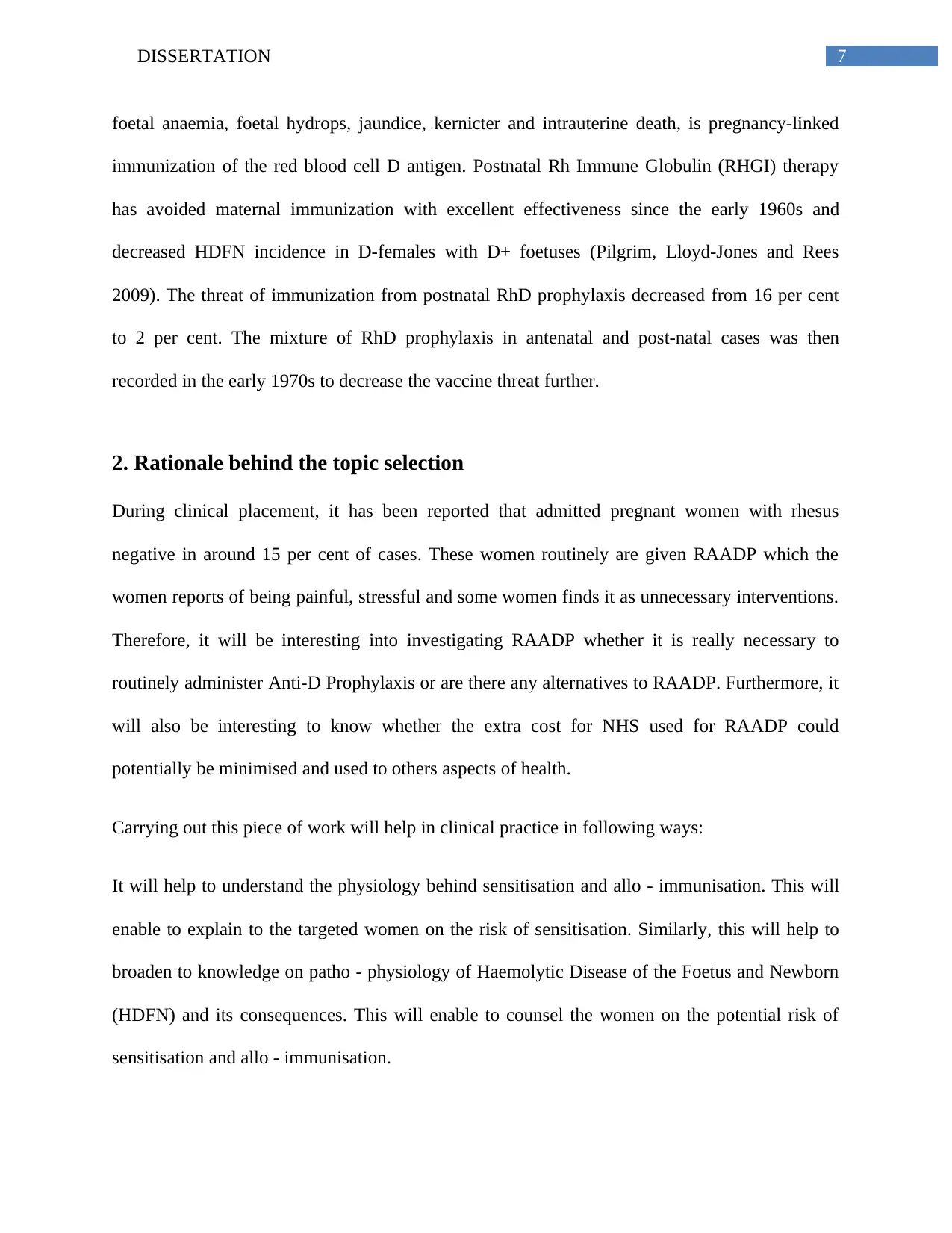
7DISSERTATION
foetal anaemia, foetal hydrops, jaundice, kernicter and intrauterine death, is pregnancy-linked
immunization of the red blood cell D antigen. Postnatal Rh Immune Globulin (RHGI) therapy
has avoided maternal immunization with excellent effectiveness since the early 1960s and
decreased HDFN incidence in D-females with D+ foetuses (Pilgrim, Lloyd-Jones and Rees
2009). The threat of immunization from postnatal RhD prophylaxis decreased from 16 per cent
to 2 per cent. The mixture of RhD prophylaxis in antenatal and post-natal cases was then
recorded in the early 1970s to decrease the vaccine threat further.
2. Rationale behind the topic selection
During clinical placement, it has been reported that admitted pregnant women with rhesus
negative in around 15 per cent of cases. These women routinely are given RAADP which the
women reports of being painful, stressful and some women finds it as unnecessary interventions.
Therefore, it will be interesting into investigating RAADP whether it is really necessary to
routinely administer Anti-D Prophylaxis or are there any alternatives to RAADP. Furthermore, it
will also be interesting to know whether the extra cost for NHS used for RAADP could
potentially be minimised and used to others aspects of health.
Carrying out this piece of work will help in clinical practice in following ways:
It will help to understand the physiology behind sensitisation and allo - immunisation. This will
enable to explain to the targeted women on the risk of sensitisation. Similarly, this will help to
broaden to knowledge on patho - physiology of Haemolytic Disease of the Foetus and Newborn
(HDFN) and its consequences. This will enable to counsel the women on the potential risk of
sensitisation and allo - immunisation.
foetal anaemia, foetal hydrops, jaundice, kernicter and intrauterine death, is pregnancy-linked
immunization of the red blood cell D antigen. Postnatal Rh Immune Globulin (RHGI) therapy
has avoided maternal immunization with excellent effectiveness since the early 1960s and
decreased HDFN incidence in D-females with D+ foetuses (Pilgrim, Lloyd-Jones and Rees
2009). The threat of immunization from postnatal RhD prophylaxis decreased from 16 per cent
to 2 per cent. The mixture of RhD prophylaxis in antenatal and post-natal cases was then
recorded in the early 1970s to decrease the vaccine threat further.
2. Rationale behind the topic selection
During clinical placement, it has been reported that admitted pregnant women with rhesus
negative in around 15 per cent of cases. These women routinely are given RAADP which the
women reports of being painful, stressful and some women finds it as unnecessary interventions.
Therefore, it will be interesting into investigating RAADP whether it is really necessary to
routinely administer Anti-D Prophylaxis or are there any alternatives to RAADP. Furthermore, it
will also be interesting to know whether the extra cost for NHS used for RAADP could
potentially be minimised and used to others aspects of health.
Carrying out this piece of work will help in clinical practice in following ways:
It will help to understand the physiology behind sensitisation and allo - immunisation. This will
enable to explain to the targeted women on the risk of sensitisation. Similarly, this will help to
broaden to knowledge on patho - physiology of Haemolytic Disease of the Foetus and Newborn
(HDFN) and its consequences. This will enable to counsel the women on the potential risk of
sensitisation and allo - immunisation.
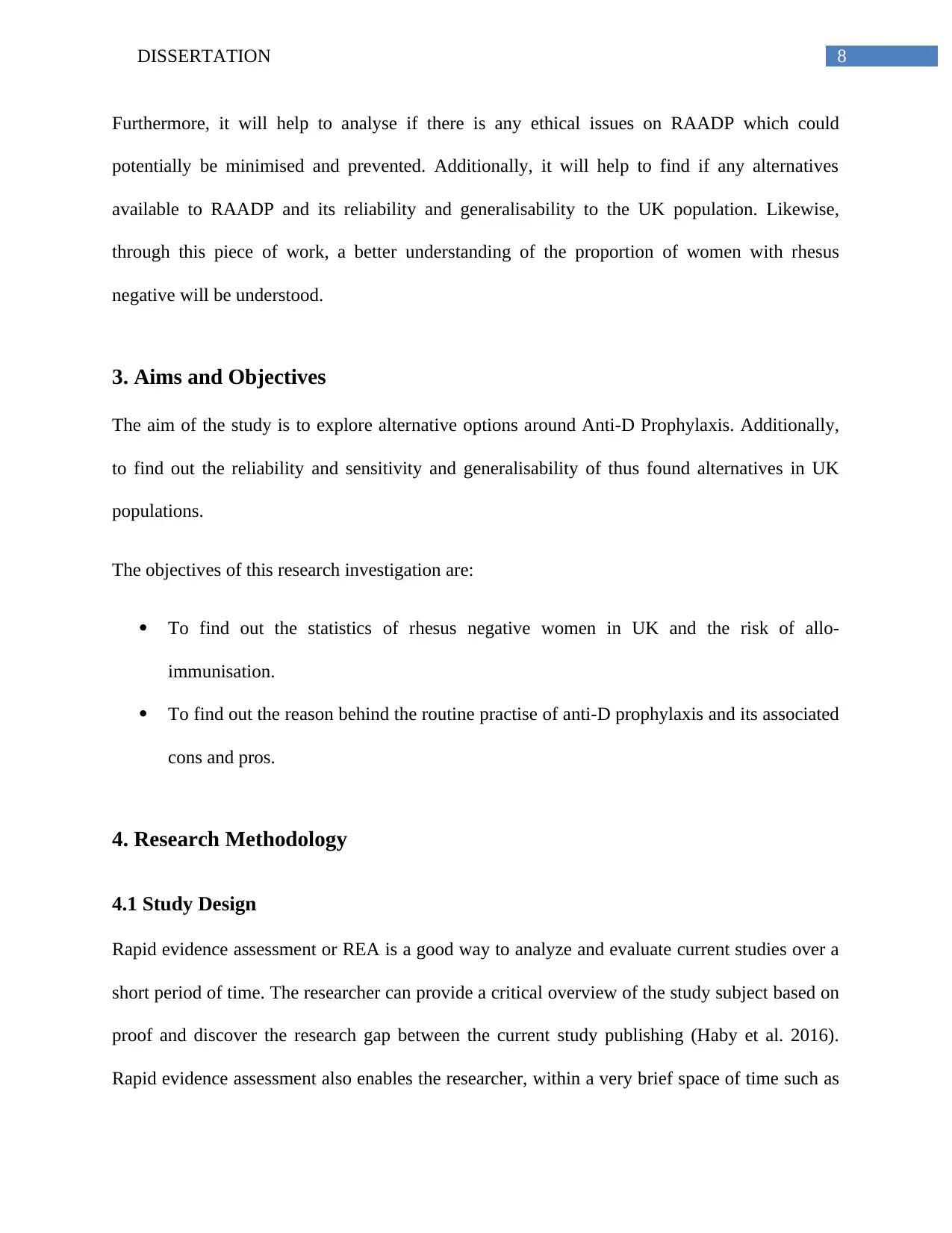
8DISSERTATION
Furthermore, it will help to analyse if there is any ethical issues on RAADP which could
potentially be minimised and prevented. Additionally, it will help to find if any alternatives
available to RAADP and its reliability and generalisability to the UK population. Likewise,
through this piece of work, a better understanding of the proportion of women with rhesus
negative will be understood.
3. Aims and Objectives
The aim of the study is to explore alternative options around Anti-D Prophylaxis. Additionally,
to find out the reliability and sensitivity and generalisability of thus found alternatives in UK
populations.
The objectives of this research investigation are:
To find out the statistics of rhesus negative women in UK and the risk of allo-
immunisation.
To find out the reason behind the routine practise of anti-D prophylaxis and its associated
cons and pros.
4. Research Methodology
4.1 Study Design
Rapid evidence assessment or REA is a good way to analyze and evaluate current studies over a
short period of time. The researcher can provide a critical overview of the study subject based on
proof and discover the research gap between the current study publishing (Haby et al. 2016).
Rapid evidence assessment also enables the researcher, within a very brief space of time such as
Furthermore, it will help to analyse if there is any ethical issues on RAADP which could
potentially be minimised and prevented. Additionally, it will help to find if any alternatives
available to RAADP and its reliability and generalisability to the UK population. Likewise,
through this piece of work, a better understanding of the proportion of women with rhesus
negative will be understood.
3. Aims and Objectives
The aim of the study is to explore alternative options around Anti-D Prophylaxis. Additionally,
to find out the reliability and sensitivity and generalisability of thus found alternatives in UK
populations.
The objectives of this research investigation are:
To find out the statistics of rhesus negative women in UK and the risk of allo-
immunisation.
To find out the reason behind the routine practise of anti-D prophylaxis and its associated
cons and pros.
4. Research Methodology
4.1 Study Design
Rapid evidence assessment or REA is a good way to analyze and evaluate current studies over a
short period of time. The researcher can provide a critical overview of the study subject based on
proof and discover the research gap between the current study publishing (Haby et al. 2016).
Rapid evidence assessment also enables the researcher, within a very brief space of time such as
⊘ This is a preview!⊘
Do you want full access?
Subscribe today to unlock all pages.

Trusted by 1+ million students worldwide
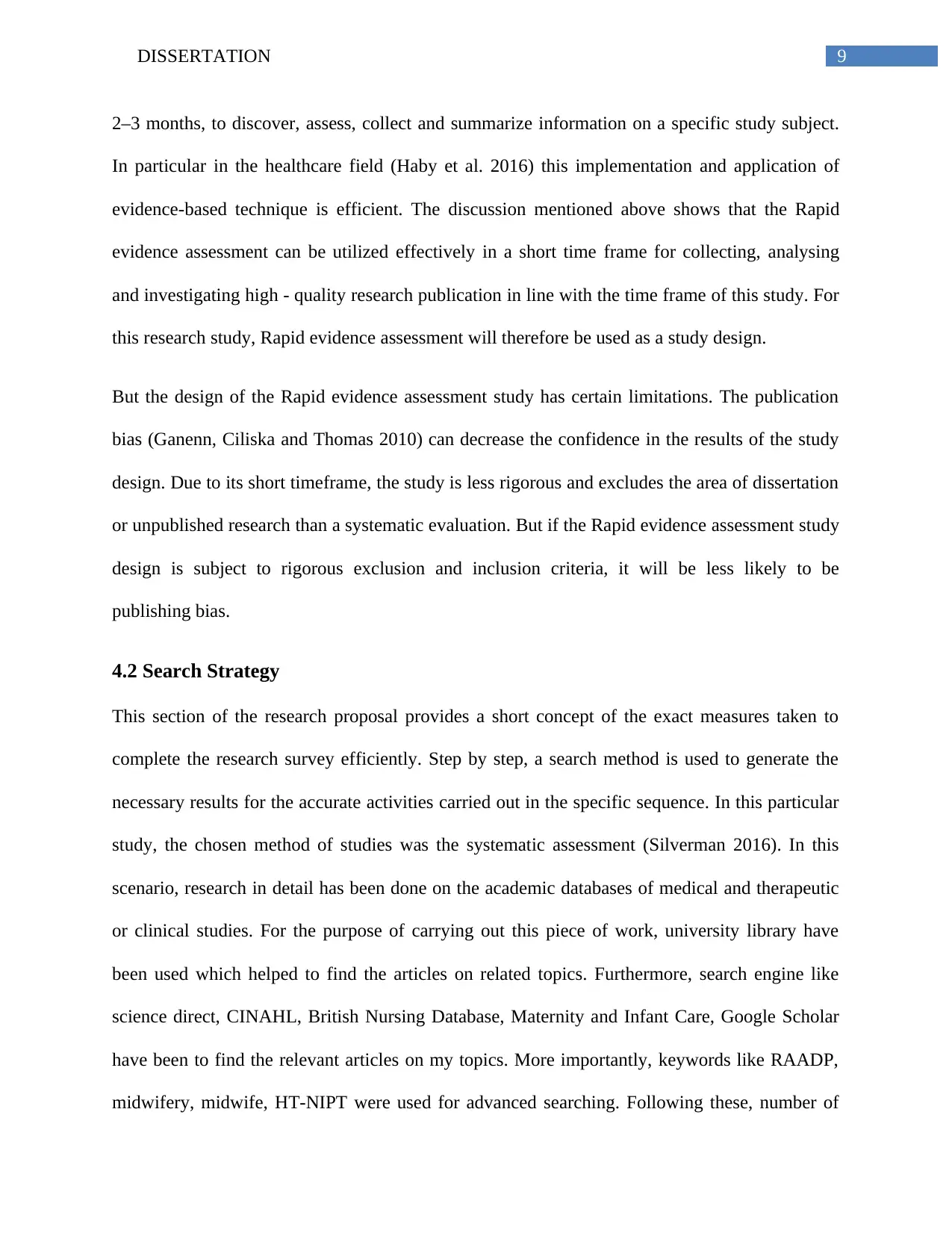
9DISSERTATION
2–3 months, to discover, assess, collect and summarize information on a specific study subject.
In particular in the healthcare field (Haby et al. 2016) this implementation and application of
evidence-based technique is efficient. The discussion mentioned above shows that the Rapid
evidence assessment can be utilized effectively in a short time frame for collecting, analysing
and investigating high - quality research publication in line with the time frame of this study. For
this research study, Rapid evidence assessment will therefore be used as a study design.
But the design of the Rapid evidence assessment study has certain limitations. The publication
bias (Ganenn, Ciliska and Thomas 2010) can decrease the confidence in the results of the study
design. Due to its short timeframe, the study is less rigorous and excludes the area of dissertation
or unpublished research than a systematic evaluation. But if the Rapid evidence assessment study
design is subject to rigorous exclusion and inclusion criteria, it will be less likely to be
publishing bias.
4.2 Search Strategy
This section of the research proposal provides a short concept of the exact measures taken to
complete the research survey efficiently. Step by step, a search method is used to generate the
necessary results for the accurate activities carried out in the specific sequence. In this particular
study, the chosen method of studies was the systematic assessment (Silverman 2016). In this
scenario, research in detail has been done on the academic databases of medical and therapeutic
or clinical studies. For the purpose of carrying out this piece of work, university library have
been used which helped to find the articles on related topics. Furthermore, search engine like
science direct, CINAHL, British Nursing Database, Maternity and Infant Care, Google Scholar
have been to find the relevant articles on my topics. More importantly, keywords like RAADP,
midwifery, midwife, HT-NIPT were used for advanced searching. Following these, number of
2–3 months, to discover, assess, collect and summarize information on a specific study subject.
In particular in the healthcare field (Haby et al. 2016) this implementation and application of
evidence-based technique is efficient. The discussion mentioned above shows that the Rapid
evidence assessment can be utilized effectively in a short time frame for collecting, analysing
and investigating high - quality research publication in line with the time frame of this study. For
this research study, Rapid evidence assessment will therefore be used as a study design.
But the design of the Rapid evidence assessment study has certain limitations. The publication
bias (Ganenn, Ciliska and Thomas 2010) can decrease the confidence in the results of the study
design. Due to its short timeframe, the study is less rigorous and excludes the area of dissertation
or unpublished research than a systematic evaluation. But if the Rapid evidence assessment study
design is subject to rigorous exclusion and inclusion criteria, it will be less likely to be
publishing bias.
4.2 Search Strategy
This section of the research proposal provides a short concept of the exact measures taken to
complete the research survey efficiently. Step by step, a search method is used to generate the
necessary results for the accurate activities carried out in the specific sequence. In this particular
study, the chosen method of studies was the systematic assessment (Silverman 2016). In this
scenario, research in detail has been done on the academic databases of medical and therapeutic
or clinical studies. For the purpose of carrying out this piece of work, university library have
been used which helped to find the articles on related topics. Furthermore, search engine like
science direct, CINAHL, British Nursing Database, Maternity and Infant Care, Google Scholar
have been to find the relevant articles on my topics. More importantly, keywords like RAADP,
midwifery, midwife, HT-NIPT were used for advanced searching. Following these, number of
Paraphrase This Document
Need a fresh take? Get an instant paraphrase of this document with our AI Paraphraser
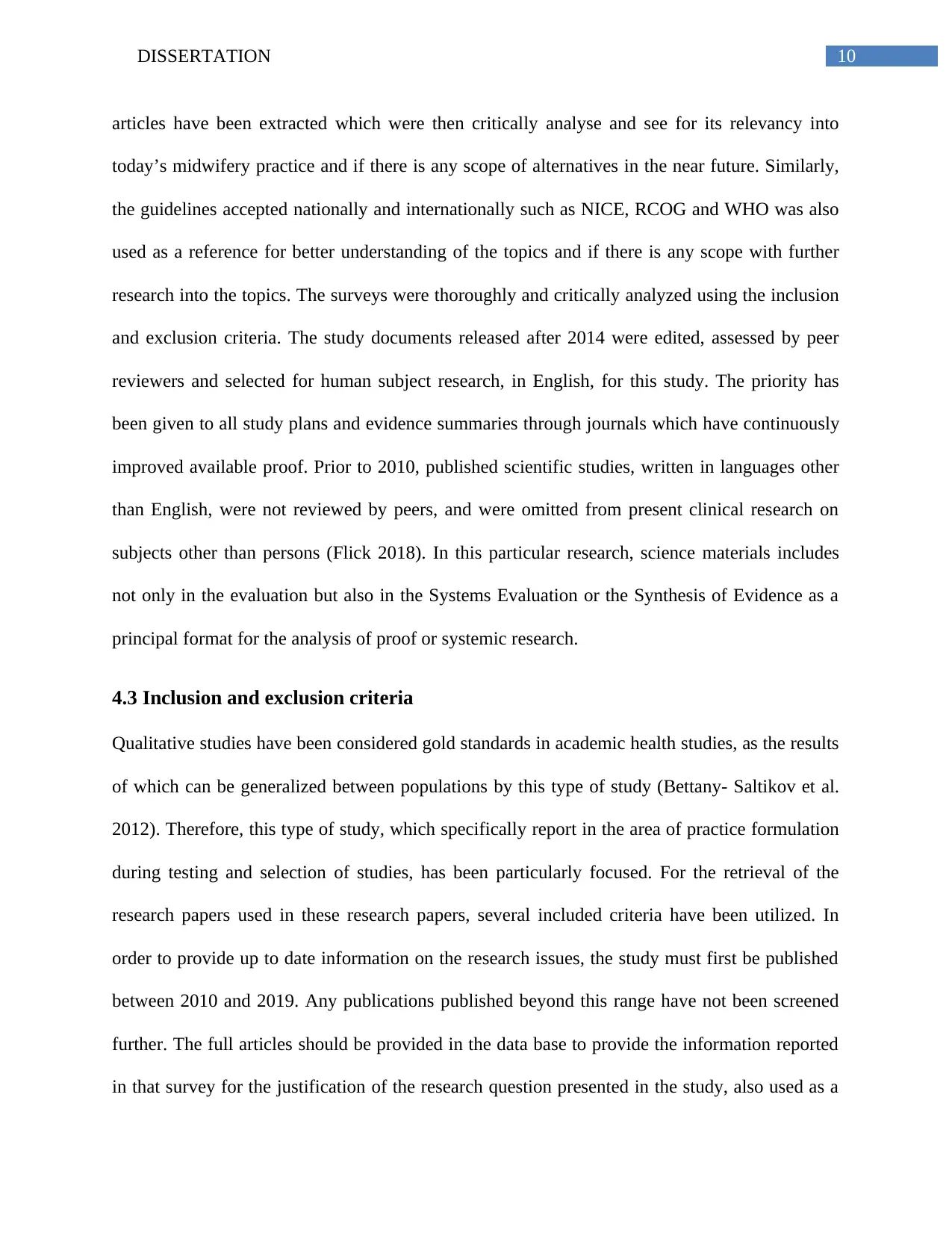
10DISSERTATION
articles have been extracted which were then critically analyse and see for its relevancy into
today’s midwifery practice and if there is any scope of alternatives in the near future. Similarly,
the guidelines accepted nationally and internationally such as NICE, RCOG and WHO was also
used as a reference for better understanding of the topics and if there is any scope with further
research into the topics. The surveys were thoroughly and critically analyzed using the inclusion
and exclusion criteria. The study documents released after 2014 were edited, assessed by peer
reviewers and selected for human subject research, in English, for this study. The priority has
been given to all study plans and evidence summaries through journals which have continuously
improved available proof. Prior to 2010, published scientific studies, written in languages other
than English, were not reviewed by peers, and were omitted from present clinical research on
subjects other than persons (Flick 2018). In this particular research, science materials includes
not only in the evaluation but also in the Systems Evaluation or the Synthesis of Evidence as a
principal format for the analysis of proof or systemic research.
4.3 Inclusion and exclusion criteria
Qualitative studies have been considered gold standards in academic health studies, as the results
of which can be generalized between populations by this type of study (Bettany- Saltikov et al.
2012). Therefore, this type of study, which specifically report in the area of practice formulation
during testing and selection of studies, has been particularly focused. For the retrieval of the
research papers used in these research papers, several included criteria have been utilized. In
order to provide up to date information on the research issues, the study must first be published
between 2010 and 2019. Any publications published beyond this range have not been screened
further. The full articles should be provided in the data base to provide the information reported
in that survey for the justification of the research question presented in the study, also used as a
articles have been extracted which were then critically analyse and see for its relevancy into
today’s midwifery practice and if there is any scope of alternatives in the near future. Similarly,
the guidelines accepted nationally and internationally such as NICE, RCOG and WHO was also
used as a reference for better understanding of the topics and if there is any scope with further
research into the topics. The surveys were thoroughly and critically analyzed using the inclusion
and exclusion criteria. The study documents released after 2014 were edited, assessed by peer
reviewers and selected for human subject research, in English, for this study. The priority has
been given to all study plans and evidence summaries through journals which have continuously
improved available proof. Prior to 2010, published scientific studies, written in languages other
than English, were not reviewed by peers, and were omitted from present clinical research on
subjects other than persons (Flick 2018). In this particular research, science materials includes
not only in the evaluation but also in the Systems Evaluation or the Synthesis of Evidence as a
principal format for the analysis of proof or systemic research.
4.3 Inclusion and exclusion criteria
Qualitative studies have been considered gold standards in academic health studies, as the results
of which can be generalized between populations by this type of study (Bettany- Saltikov et al.
2012). Therefore, this type of study, which specifically report in the area of practice formulation
during testing and selection of studies, has been particularly focused. For the retrieval of the
research papers used in these research papers, several included criteria have been utilized. In
order to provide up to date information on the research issues, the study must first be published
between 2010 and 2019. Any publications published beyond this range have not been screened
further. The full articles should be provided in the data base to provide the information reported
in that survey for the justification of the research question presented in the study, also used as a
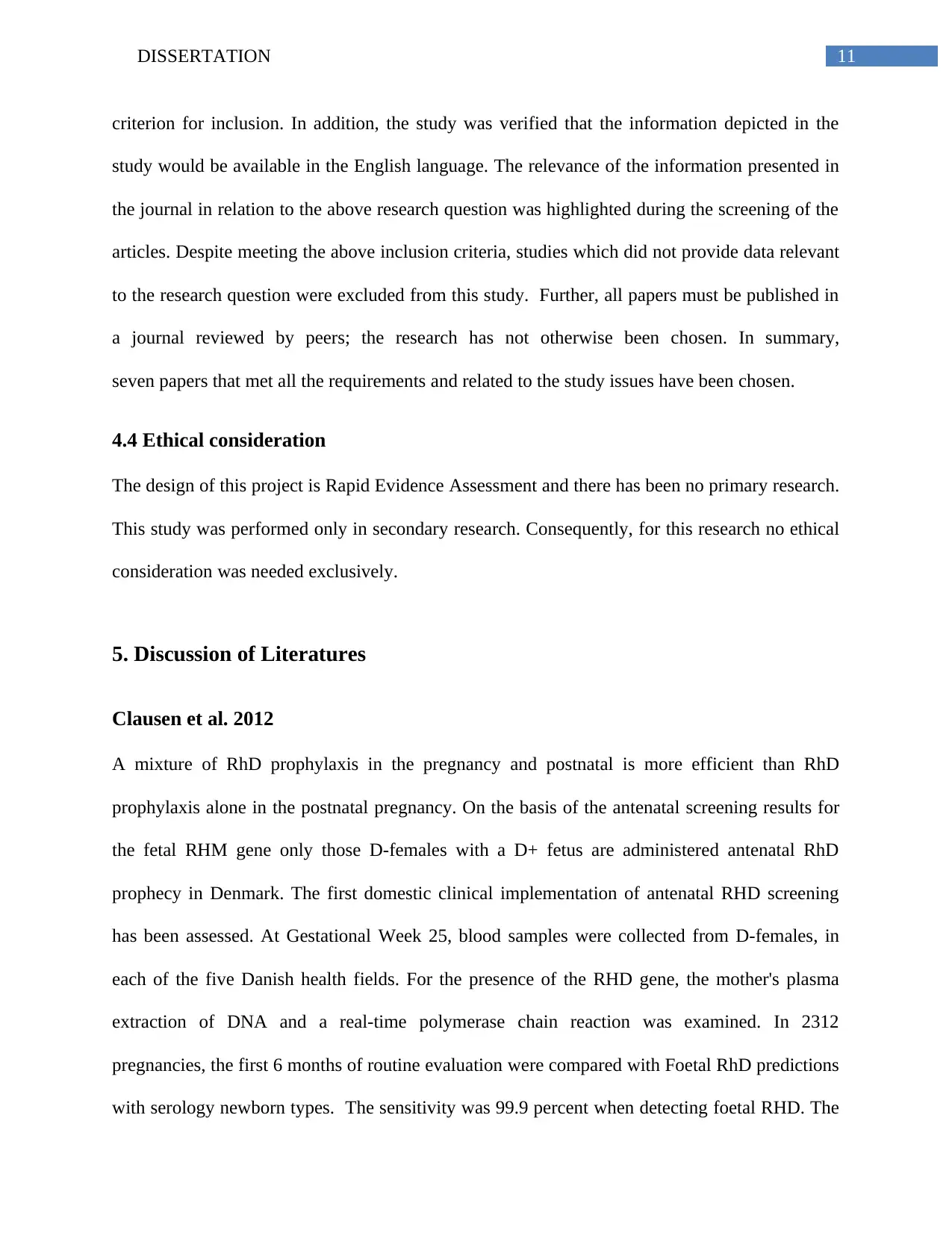
11DISSERTATION
criterion for inclusion. In addition, the study was verified that the information depicted in the
study would be available in the English language. The relevance of the information presented in
the journal in relation to the above research question was highlighted during the screening of the
articles. Despite meeting the above inclusion criteria, studies which did not provide data relevant
to the research question were excluded from this study. Further, all papers must be published in
a journal reviewed by peers; the research has not otherwise been chosen. In summary,
seven papers that met all the requirements and related to the study issues have been chosen.
4.4 Ethical consideration
The design of this project is Rapid Evidence Assessment and there has been no primary research.
This study was performed only in secondary research. Consequently, for this research no ethical
consideration was needed exclusively.
5. Discussion of Literatures
Clausen et al. 2012
A mixture of RhD prophylaxis in the pregnancy and postnatal is more efficient than RhD
prophylaxis alone in the postnatal pregnancy. On the basis of the antenatal screening results for
the fetal RHM gene only those D-females with a D+ fetus are administered antenatal RhD
prophecy in Denmark. The first domestic clinical implementation of antenatal RHD screening
has been assessed. At Gestational Week 25, blood samples were collected from D-females, in
each of the five Danish health fields. For the presence of the RHD gene, the mother's plasma
extraction of DNA and a real-time polymerase chain reaction was examined. In 2312
pregnancies, the first 6 months of routine evaluation were compared with Foetal RhD predictions
with serology newborn types. The sensitivity was 99.9 percent when detecting foetal RHD. The
criterion for inclusion. In addition, the study was verified that the information depicted in the
study would be available in the English language. The relevance of the information presented in
the journal in relation to the above research question was highlighted during the screening of the
articles. Despite meeting the above inclusion criteria, studies which did not provide data relevant
to the research question were excluded from this study. Further, all papers must be published in
a journal reviewed by peers; the research has not otherwise been chosen. In summary,
seven papers that met all the requirements and related to the study issues have been chosen.
4.4 Ethical consideration
The design of this project is Rapid Evidence Assessment and there has been no primary research.
This study was performed only in secondary research. Consequently, for this research no ethical
consideration was needed exclusively.
5. Discussion of Literatures
Clausen et al. 2012
A mixture of RhD prophylaxis in the pregnancy and postnatal is more efficient than RhD
prophylaxis alone in the postnatal pregnancy. On the basis of the antenatal screening results for
the fetal RHM gene only those D-females with a D+ fetus are administered antenatal RhD
prophecy in Denmark. The first domestic clinical implementation of antenatal RHD screening
has been assessed. At Gestational Week 25, blood samples were collected from D-females, in
each of the five Danish health fields. For the presence of the RHD gene, the mother's plasma
extraction of DNA and a real-time polymerase chain reaction was examined. In 2312
pregnancies, the first 6 months of routine evaluation were compared with Foetal RhD predictions
with serology newborn types. The sensitivity was 99.9 percent when detecting foetal RHD. The
⊘ This is a preview!⊘
Do you want full access?
Subscribe today to unlock all pages.

Trusted by 1+ million students worldwide
1 out of 28
Your All-in-One AI-Powered Toolkit for Academic Success.
+13062052269
info@desklib.com
Available 24*7 on WhatsApp / Email
![[object Object]](/_next/static/media/star-bottom.7253800d.svg)
Unlock your academic potential
Copyright © 2020–2025 A2Z Services. All Rights Reserved. Developed and managed by ZUCOL.